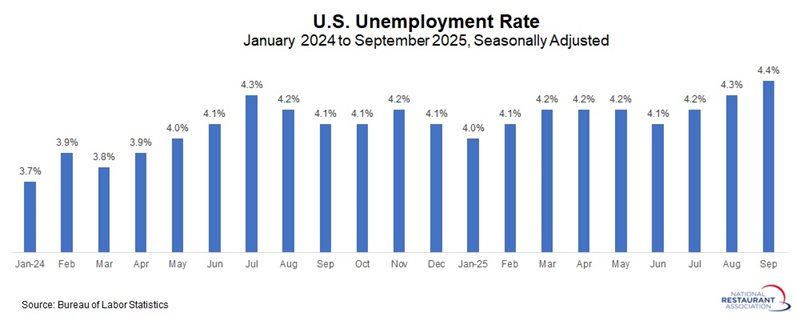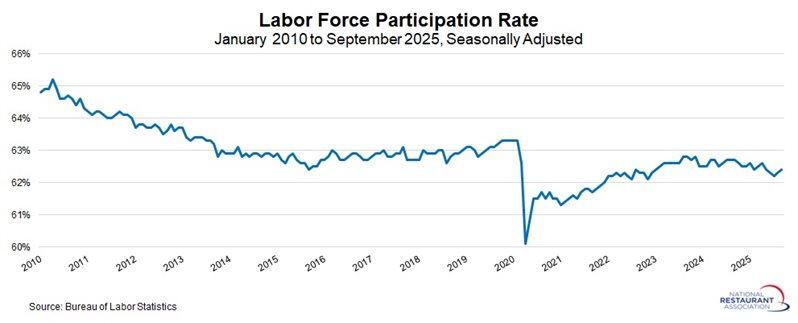Research
November 20, 2025
Total U.S. jobs
U.S. employment slows since the spring but beats expectations in September
The U.S. economy added 119,000 nonfarm payroll jobs in September, surpassing the consensus forecast of roughly 50,000. This report was delayed due to the recent government shutdown. While hiring remains positive, employment growth has moderated significantly since the spring. From May through September, the economy added a net 193,000 jobs, compared to 814,000 jobs in the previous five-month period (December to April).
Notably, during this recent jobs slowdown, nonfarm payrolls declined in both June (down 13,000) and August (down 4,000). These figures reflect downward revisions in July and August totaling 33,000 fewer workers than previously estimated, with August job growth originally reported at 22,000.
With growth in September, total nonfarm payroll employment continued to move higher, reaching a record 159.645 million. Indeed, the U.S. economy has demonstrated surprising resilience over the past few years, navigating multiple headwinds and an uncertain policy environment. However, the recent softening in labor market conditions could challenge the prevailing narrative of post-pandemic strength. Steady employment and wage growth have been key drivers of consumer spending, and any sustained weakness could weigh on economic activity.
Restaurant operators are closely monitoring labor trends as they seek to drive traffic and sales, especially given the recent softness. At the same time, while challenges remain, there are also positive indicators that could support performance in the sector, with mixed economic news overall. Labor market developments will be critical to watch in the coming months as businesses adapt to evolving economic and policy dynamics.
October data will not be released, as they were not collected during the government shutdown, with November figures slated to be published on December 5.
In September, the unemployment rate edged higher for the third straight month, rising to 4.4%, the highest since October 2021. The number of unemployed individuals increased from 7.38 million to 7.60 million, a 4-year high. At the same time, the number of employed individuals rose from 163.39 million to 163.65, remaining below April’s record high of 163.94 million.
The labor force participation rate rose from 62.3% to 62.4%, edging up for the second straight month after pulling back in prior months. While the rate has generally languished over the past year—suggesting that more prospective workers have stepped away from the labor force—it is encouraging to see progress in the latest data.
Average hourly earnings for private-sector production and nonsupervisory workers rose 0.3% in September for the third consecutive month. Wages increased 3.8% year-over-year, a solid pace of growth. Even so, labor cost pressures have moderated significantly from the recent peak of 7.0% in March 2022.
Job growth in September was mixed. There were gains in private education and health services, leisure and hospitality (including eating and drinking places), construction, state and local government, retail sales, and financial activities. In contrast, there were notable job declines in professional and business services, manufacturing, mining and logging, and the federal government. The private sector added 97,000 jobs, while government employment rose by 22,000 overall. Below is a detailed breakdown of September’s employment changes by sector, ranked from highest to lowest:
Notably, during this recent jobs slowdown, nonfarm payrolls declined in both June (down 13,000) and August (down 4,000). These figures reflect downward revisions in July and August totaling 33,000 fewer workers than previously estimated, with August job growth originally reported at 22,000.
With growth in September, total nonfarm payroll employment continued to move higher, reaching a record 159.645 million. Indeed, the U.S. economy has demonstrated surprising resilience over the past few years, navigating multiple headwinds and an uncertain policy environment. However, the recent softening in labor market conditions could challenge the prevailing narrative of post-pandemic strength. Steady employment and wage growth have been key drivers of consumer spending, and any sustained weakness could weigh on economic activity.
Restaurant operators are closely monitoring labor trends as they seek to drive traffic and sales, especially given the recent softness. At the same time, while challenges remain, there are also positive indicators that could support performance in the sector, with mixed economic news overall. Labor market developments will be critical to watch in the coming months as businesses adapt to evolving economic and policy dynamics.
October data will not be released, as they were not collected during the government shutdown, with November figures slated to be published on December 5.

In September, the unemployment rate edged higher for the third straight month, rising to 4.4%, the highest since October 2021. The number of unemployed individuals increased from 7.38 million to 7.60 million, a 4-year high. At the same time, the number of employed individuals rose from 163.39 million to 163.65, remaining below April’s record high of 163.94 million.

The labor force participation rate rose from 62.3% to 62.4%, edging up for the second straight month after pulling back in prior months. While the rate has generally languished over the past year—suggesting that more prospective workers have stepped away from the labor force—it is encouraging to see progress in the latest data.

Average hourly earnings for private-sector production and nonsupervisory workers rose 0.3% in September for the third consecutive month. Wages increased 3.8% year-over-year, a solid pace of growth. Even so, labor cost pressures have moderated significantly from the recent peak of 7.0% in March 2022.

Job growth in September was mixed. There were gains in private education and health services, leisure and hospitality (including eating and drinking places), construction, state and local government, retail sales, and financial activities. In contrast, there were notable job declines in professional and business services, manufacturing, mining and logging, and the federal government. The private sector added 97,000 jobs, while government employment rose by 22,000 overall. Below is a detailed breakdown of September’s employment changes by sector, ranked from highest to lowest:
- Private education and health services: +59,000
- Leisure and hospitality: +47,000 (eating and drinking places: +36,500)
- Construction: 19,000
- State government: 16,000
- Local government: +9,000
- Financial activities: 5,000
- Information: no change
- Other services: -2,000
- Trade, transportation, and utilities: -2,000 (retail trade: +13,900)
- Federal government: -3,000
- Mining and logging: -3,000
- Manufacturing: -6,000
- Professional and business services: -20,000